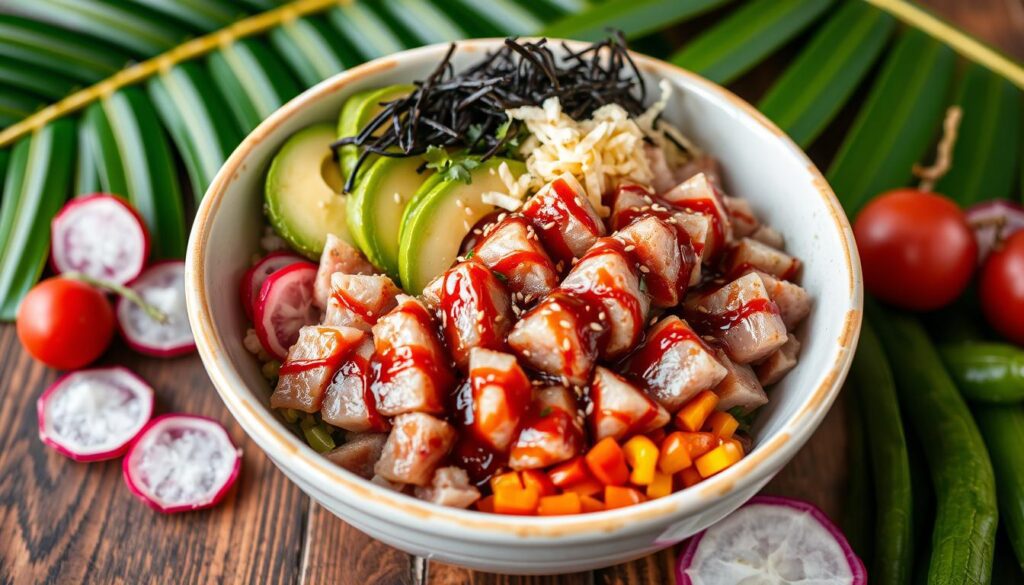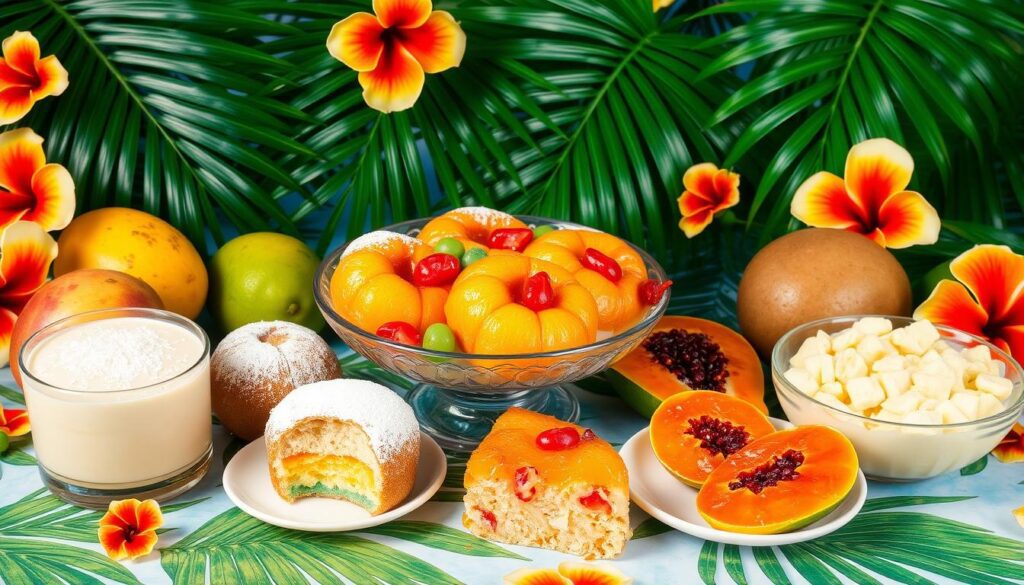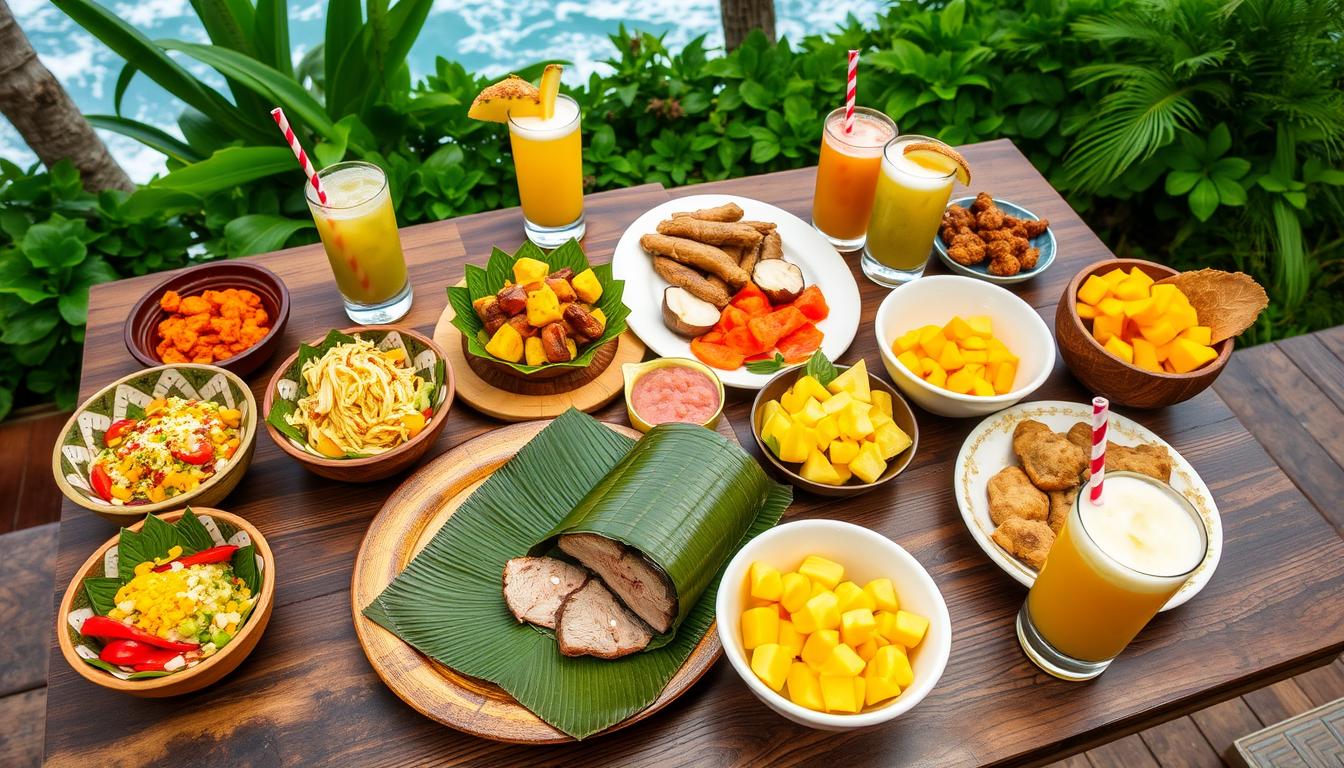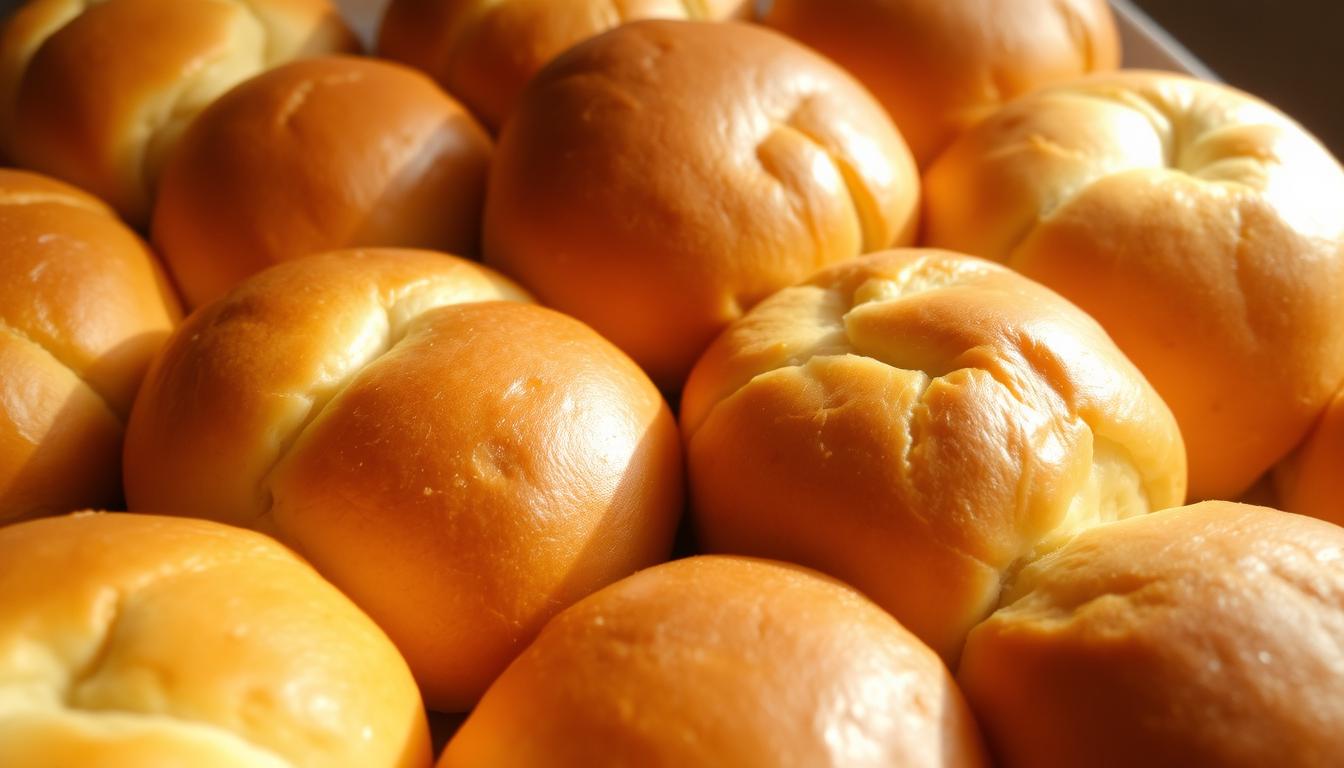Hawaii’s cuisine is a rich tapestry of flavors, shaped by both its native inhabitants and international influences. The food scene here is a vibrant mix of traditional Hawaiian dishes and those with Polynesian, European, and Asian roots. Recently, the concept of ‘Hawaii regional cuisine’ has emerged. It’s an effort by local chefs to highlight fresh local ingredients while blending the diverse flavors introduced by various countries.
Hawaiian cuisine beautifully reflects the cultural crossroads of the Hawaiian Islands. It showcases the deep respect Native Hawaiians have for the land and sea. It also celebrates the cultural influences brought by immigrants. This fusion of traditions offers a wide array of flavors to explore.
Key Takeaways
- Hawaiian cuisine is a fusion of Polynesian, North American, and East Asian influences.
- Traditional Hawaiian dishes feature local ingredients like taro, coconut, pineapple, and fresh seafood.
- Iconic Hawaiian dishes include poke bowls, spam musubi, kalua pork, and haupia.
- The Hawaiian plate lunch is a staple, often consisting of rice, macaroni salad, and a protein.
- Shave ice and macadamia nuts are beloved Hawaiian treats.
The Melting Pot of Hawaiian Cuisine
Polynesians arrived in Hawai’i thousands of years ago, bringing a deep respect for the land and its resources. Their traditional cuisine focused on fresh, local ingredients like kalo (taro plant) and the abundant fish from the waters.
In the 18th and 19th centuries, immigrants from China, Japan, Portugal, and other places arrived. Each group brought their own culinary traditions. The Chinese introduced lau lau, the Portuguese brought pork and sweet breads, and the Japanese created innovative dishes using local ingredients.
Blending Native Traditions with Immigrant Influences
This cultural exchange transformed Hawaiian cuisine. The mix of diverse immigrant influences and Polynesian heritage led to a unique fusion cuisine. Today, Hawaiian food evolves, embracing new ideas while honoring its traditional roots in Hawaiian cuisine.
From Polynesian Roots to Modern Fusion
Hawaiian cuisine’s story is one of continuous evolution, showcasing the island’s people’s resilience and adaptability. From ancient Polynesian cuisine to today’s fusion cuisine, Hawai’i’s food reflects its diverse cultural heritage.
Iconic Hawaiian Dishes to Savor

Hawaii’s culinary scene is a vibrant mix of flavors, blending indigenous Polynesian traditions with diverse cultural influences. Iconic dishes like kalua pork and poke bowls captivate both locals and visitors. These dishes are a testament to the islands’ rich culinary heritage.
Kalua Pork: The Smoky Delight of the Imu
Kalua pork is a cherished part of Hawaiian cuisine, with roots dating back centuries. It’s cooked in an imu, an underground oven, using volcanic rock’s natural heat. This method imparts a smoky flavor and tender texture that’s irresistible.
Kalua pork is a highlight at Hawaiian luaus. The cooking process is often showcased, giving guests a glimpse into the islands’ cultural heritage.
Poke Bowls: A Taste of the Ocean
Poke bowls have gained worldwide fame, but their roots are deeply rooted in Hawaiian traditions. At its core, poke is raw ahi tuna seasoned with soy sauce, sesame oil, Maui onions, and limu (seaweed). Paired with steamed white rice, poke bowls celebrate the Hawaiian islands’ abundant seafood.
| Dish | Key Ingredients | Culinary Significance |
|---|---|---|
| Kalua Pork | Whole Pig, Imu (Underground Oven) | Traditional Hawaiian cooking method, Signature dish at Luaus |
| Poke Bowls | Ahi Tuna, Soy Sauce, Sesame Oil, Maui Onions, Limu | Raw fish salad, Showcases fresh local seafood |
Hawaiian food and cuisine
Hawaiians have long embraced the salty and savory flavors of Spam, a canned meat introduced during World War II. This ingredient has become a staple in Hawaiian cuisine, leading to the creation of iconic dishes like Spam Musubi and Loco Moco.
Spam Musubi is a beloved snack featuring seared Spam slices on sticky rice, wrapped in seaweed. It exemplifies Hawaiian cuisine’s resourcefulness and adaptability, combining flavors and textures in a unique way.
Loco Moco is another quintessential dish, consisting of a hamburger patty, brown gravy, and a fried egg on white rice. It reflects the island’s diverse influences, blending creativity and local flavors for a unique culinary experience.
These dishes, among others, demonstrate the lasting appeal of spam musubi, loco moco, and other Hawaiian comfort foods. They highlight the resilience and adaptability of Hawaiian cuisine, which has merged global influences to forge a distinctive local identity.
Exploring Traditional Hawaiian Fare
Hawaii’s cuisine is a captivating blend of Polynesian heritage, immigrant influences, and modern culinary innovation. At its core are two iconic dishes: poi and laulau.
Poi: The Taro-Based Staple
Poi is a cornerstone of Hawaiian cuisine, crafted by boiling, baking, or steaming taro root. It’s then pounded with water until smooth and creamy. This staple has been a mainstay for Native Hawaiians for centuries, often paired with kalua pork and seasoned with a hint of salt.
The texture and taste of poi vary, from a thick paste to a slightly sour, fermented flavor when aged. Yet, it remains a vital part of traditional Hawaiian dining, connecting people to their cultural heritage.
Laulau: The Leaf-Wrapped Delicacy
Laulau is a cherished traditional Hawaiian dish that highlights the island’s natural abundance. It involves wrapping pork, fish, or chicken in taro leaves and steaming them. This process infuses the packets with the leaves’ fragrant, earthy flavors.
The result is a tender, flavorful dish that reflects Native Hawaiians’ deep bond with the land and sea. The use of traditional cooking methods and local ingredients in dishes like laulau and poi showcases the rich culinary heritage of the Hawaiian Islands.
Sweet Treats of the Islands

Hawaii is famous for its desserts, blending tropical tastes with local traditions. The creamy haupia and the cool shave ice are just a few of the Hawaiian desserts to try. These treats are a true delight for anyone with a sweet tooth.
Haupia: The Coconut Milk Pudding
Haupia is a traditional Hawaiian dessert, made from coconut milk and thickened with arrowroot or cornstarch. It’s a smooth, creamy pudding with a distinct coconut flavor. Often enjoyed at luaus, weddings, and other celebrations, it highlights the islands’ rich culinary heritage.
Shave Ice: A Refreshing Indulgence
Shave ice is a beloved treat with roots in Polynesian bingsu and Japanese kakigori. It combines finely flaked ice with coconut milk and tropical fruit syrups. Topped with sweetened condensed milk and sometimes haupia or ice cream, it’s a refreshing delight.
These desserts showcase the vibrant Hawaiian dessert scene. From the creamy haupia to the cool shave ice, there’s something for everyone. Try these local treats and experience the unique flavors that make Hawaiian cuisine so special.
Fresh Seafood Delights of Maui
Maui, the second-largest island in the Hawaiian archipelago, is celebrated for its vibrant seafood scene. It’s surrounded by the vast Pacific Ocean, offering an abundance of fresh, sustainably sourced seafood. This has become a key part of the local cuisine.
At the Seascape Restaurant, located within the Maui Ocean Center, visitors can enjoy a variety of seafood dishes. These dishes reflect the island’s culinary heritage. Executive Chef Enrique “Henry” Tariga, an award-winning culinary maestro, has crafted a menu blending Polynesian, Asian, and local flavors. This creates a unique dining experience.
The Seascape Restaurant embodies the essence of Maui’s seafood delights. Diners can savor the fresh catch of the day, prepared to highlight its natural sweetness and texture. Whether it’s a delicate poke bowl, a mouthwatering grilled catch, or a decadent seafood platter, each dish tells a story of Maui’s rich culinary heritage.
The Seascape Restaurant also showcases the island’s vibrant agricultural landscape. Local produce, from fragrant tropical fruits to farm-fresh vegetables, are carefully incorporated into the menu. This creates a harmonious fusion of land and sea.
Maui’s seafood scene extends beyond the Seascape Restaurant. A thriving network of purveyors, fishermen, and chefs are committed to sustainable practices. This commitment ensures that the delectable seafood delights found on the island remain available for generations to come.
The History of Hawaiian Luau Feasts
The Hawaiian luau, a centuries-old tradition, celebrates community, culture, and the island’s bountiful cuisine. In ancient Hawaii, ‘ahaʻaina (feast) brought people together, connecting them with nature. These grand events featured roasted pigs cooked in the imu (underground oven), along with fresh seafood and island greens.
King Kamehameha III’s 1847 luau was a notable event, with over 4,000 taro plants, 271 pigs, and 5,000 fish. In 1883, King Kalakaua’s 50th birthday luau, with over 1,500 guests, showcased the grandeur of these gatherings.
Today, the luau tradition lives on, with the unearthing of kalua pork as a key part of the ceremony. Modern luaus on Maui, Oahu, Kauai, and the Big Island offer a contemporary take on this Polynesian tradition. They feature traditional and contemporary Hawaiian cuisine, live music, hula dancing, and storytelling.
While ancient luaus were formal, today’s luaus celebrate various occasions like birthdays and weddings. Traditional dishes like huli huli chicken, kalua pork, and haupia are staples. The vibrant entertainment and lei-giving transport guests to the heart of Hawaiian culture.
The history of the Hawaiian luau reflects the islands’ enduring spirit. It celebrates community, tradition, and the abundance of land and sea, cherished by locals and visitors alike.
Fusing Flavors: Modern Hawaiian Regional Cuisine
Hawaii’s culinary scene is not just about traditional dishes. Modern chefs are now mixing these iconic flavors with new techniques. This movement, known as “Hawaii regional cuisine,” combines local produce with diverse immigrant influences. It offers a unique and captivating dining experience.
The islands’ volcanic soil and immigrant workers have created a remarkable mix of flavors. Poke bowls, for example, often feature ahi (tuna). Saimin noodle dishes blend wheat noodles, char siu, linguica, nori, and green onions.
Loco moco, a comfort food classic, has evolved. It now includes fish, teriyaki beef, chili, kalua pork, Spam, or Portuguese sausage. Traditional desserts like haupia and malasadas have also been reimagined by modern chefs.
| Culinary Trend | Traditional Influence | Modern Interpretation |
|---|---|---|
| Poke Bowls | Ahi (Tuna) | Fusion with diverse seafood and global flavors |
| Saimin Noodles | Wheat noodles, char siu, linguica, nori, green onions | Creative combinations with international ingredients |
| Loco Moco | Boiled white rice, hamburger patty, gravy, fried egg | Expanded with seafood, teriyaki, chili, and unique proteins |
| Haupia | Coconut milk, arrowroot | Infused with tropical fruits and modern presentation |
| Malasadas | Flour, sugar, eggs, milk | Innovative fillings and flavor profiles beyond traditional |
Modern Hawaiian regional cuisine is constantly evolving. It showcases the islands’ ability to blend traditional flavors with contemporary techniques. This fusion has created a vibrant, ever-changing culinary landscape. It celebrates Hawaii’s rich cultural heritage while embracing innovation.
Uncovering the Secrets of Hawaiian Salt
Hawaiians have long harnessed their islands’ natural wealth, including the production of pa’akai, or Hawaiian salt. This salt, harvested from evaporated seawater, is a key component in traditional dishes like kalua pork. It brings a distinct island flavor to these dishes. The deep respect Hawaiians have for their land and resources is evident in their use of local ingredients like pa’akai. These ingredients remain a vital part of Hawaiian cuisine.
Pa’akai: The Essence of Island Flavor
The tradition of producing pa’akai, or Hawaiian salt, is deeply rooted in Hawaiian culture. Hawaiians have long recognized the value of this natural resource, harvested from seawater evaporation. Pa’akai is essential in many traditional Hawaiian dishes, adding a unique island flavor that’s unmatched elsewhere. It’s the essence that connects these iconic dishes to Hawaii’s land and culture.
Hawaiians’ reverence for their natural resources, including pa’akai, showcases their profound connection to the ‘āina, or land. This respect is reflected in their use of local ingredients like pa’akai in their cuisine. It creates a genuine Hawaiian dining experience for both locals and visitors.

Scott Sweeney is the creator of Virtual Hawaii 360. Scott is a professional marketer and a lifelong Hawaii enthusiast. Scott splits time between Oahu and Dayton, Ohio. In addition to his marketing endevours, he is also a published Ukulele musician.





